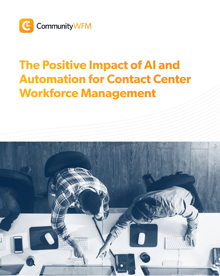
Having a complete workforce optimization (WFO) suite has become a must have solution for any modern contact center. While it was more of a “nice to have” with some components in the early 2000s, the value provided by a WFO suite of products has become essential to maximizing agent potential, especially for remote teams, while also improving agent satisfaction at the same time.
A WFO solution typically consists of several different offerings, such as…
-- Quality management (QM)
-- Performance monitoring
-- Voice and screen recording
-- Contact interaction analytics
-- Gamification
-- Customer surveys or voice of the customer (VOC)
-- And more…
However, at the core of a WFO solution is workforce management (WFM) software. Below are a few reasons why WFM software is the backbone of a workforce optimization solution and how the technology assists many of the offerings listed above.
It creates the schedule that gets agents on the clock – All of the components making up a WFO solution require an agent to show up to their shift in the first place. Workforce management software provides sophisticated and streamlined scheduling technology to get agents on the books when a contact center needs them. Failing to have a proper schedule in place would significantly reduce the effectiveness of solutions like QM and performance monitoring because there aren’t many agents to track.
It keeps an eye on agent performance so they stay on task – Normally, contact center managment will often utilize a workforce optimization solution in non-peak hours to coach agents by reviewing recordings and assessing interaction analytics. However, while these tactics are effective, they don’t help with adjusting agent behavior in real-time. WFM software provides adherence solutions that integrate directly into an active call distribution (ACD) system. This lets a WFM analyst know exactly what an agent is doing so they can make the right moves, such as temporarily postponing breaks for phone agents because call volume is high.
It predicts what will happen in the future – As alluded to in the last reason, many offerings within a workforce optimization solution are reactionary. This is because WFM software does so much of the heavy lifting on the predictive side. Data-driven forecasting, which considers many factors including historical data, is leveraged to quickly make accurate schedules days or even weeks in advance. In addition, AI and automation solutions drive day-to-day staffing recommendations for a WFM analyst to consider as they evaluate whether to staff up or down based on their needs.
It tracks agent skills and makes filling gaps easier – It’s important that the right agents can be identified quickly when a contact center does need to make staffing adjustments. WFM software is a major asset here because the software tracks agent skills as a part of its scheduling process. Need more chat agents for an evening shift? WFM software provides automated scheduling features and can identify all eligible agents with the right skills. The technology then notifies each applicable agent individually in minutes, whether they are currently working or not, about a shift opening. While other components of a workforce optimization solution are good for evaluating which skills an agent may excel at, WFM software is how these skill assignments are put into action within a contact center.
In conclusion, WFM software is the backbone of a workforce optimization solution because it ties everything together. It’s up to workforce management technology to place the right agents in the right spot at the right time so a contact center can make the most of its optimization efforts.








